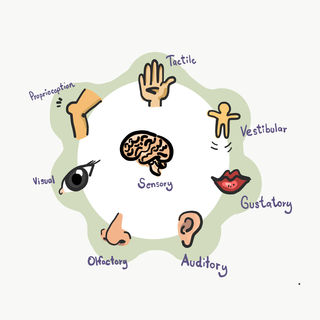ADHD
Making Sense of Sensory Overload in Autism and ADHD
When are symptoms "sensory" versus ASD or ADHD?
Posted April 19, 2020 Reviewed by Jessica Schrader

Both autism spectrum disorder (ASD) and attention-deficit-hyperactivity disorder (ADHD) are neuropsychiatric conditions involving differences in brain structure and chemistry. There are some similarities and some differences between the two. One feature they share is they may both involve “sensory overload,” although in different ways.
What is “sensory overload?"
We all perceive the world through our senses—seeing, hearing, touch, etc. At every moment we receive these inputs at a subconscious level. As I’m sitting here writing this post, I see and focus on the words I’m typing and unless I consciously tune into them, other sensory inputs such as the feeling of the chair or the smell of the air impact me only at a subconscious level. But I know my brain is monitoring those other inputs because if my house caught fire, I would eventually become aware of my seat getting very hot, the smell of smoke in the air, and a wail of approaching fire engines getting steadily louder. So subconsciously my brain monitors many different sensory inputs at all times but it is able to prioritize one so I can focus on the task at hand: “vision” in this case—so I can concentrate on the words I am typing and the messages I wish to convey in this post.
Imagine what it would be like if this selective system didn’t work well? What if at all times I was fully conscious of all sensory inputs without being able to prioritize one over others?
In the example I just gave, what if my brain had a hard time prioritizing “vision” over touch, smell, hearing, etc? Well in that case, even without my house catching fire, as I was trying to type my mind would be crowded and distracted by the sound of birds chirping outside, the smell of breakfast cooking in the next room, and how my joints feel—not to mention that scratchy little tag on the back of my shirt. It would be a heck of a lot harder to write this blog post. I would be continually overloaded with extraneous information, distracted, and frustrated!
People with ADHD and ASD, and those who have both together may have “crowded” brains like this; they have a hard time prioritizing sensory inputs. One of the criteria for ASD in the DSM (USA psychiatric diagnostic manual) is differences in sensory reactivity:
Hyper- or hyporeactivity to sensory input or unusual interests in sensory aspects of the environment (e.g., apparent indifference to pain/temperature, adverse response to specific sounds or textures, excessive smelling or touching of objects, visual fascination with lights or movement).
In other words, some people with ASD respond poorly to certain stimuli that neurotypical people respond well to, while being hypersensitive to other stimuli that neurotypical people routinely ignore. We don’t know why that is, but for many it’s an integral part of their autism.
Although hypo- or hypersensitivity to stimuli are not part of the DSM criteria for ADHD, patients with ADHD often do report it as one of their challenges. They will say, “I hear everything that’s going on,” and may, for example, have a hard time listening to the teacher if another student in the room is clicking a pen or smacking their gum.
In our offices as we conduct their exam, adults with ADHD often notice and comment on features of the room that we have never consciously noticed and that other patients don’t typically mention—such as the shape of the ceiling vent or door handle. We both have some trinkets in our exam rooms—they are chiefly there to serve as decoration or to help entertain our younger visitors—but we have found they have some diagnostic value as well: Our adult ADHD patients are often inexorably drawn to these bobbles and will play with them as we talk, frequently switching from one to another. Other adult patients may or may not notice these items and features in our offices, but will seldom comment on them or interact physically with them unless there is a major lull in the conversation or if we ourselves interrupt their visit to attend to another patient matter.
The neurobiology of processing sensory stimuli has been worked out to some degree, but exactly how it relates to ASD or ADHD is not well-understood. Scientists who study autism neurobiology, for example, don’t generally study the biology of vision, olfaction, or touch—and so far there’s been relatively little scientific research aimed at relating the two. However, psychological studies and clinical rating scales do show that sensory processing is frequently altered in both ADHD and ASD.
Clinically speaking, difficulty with processing too many inputs can be frustrating, anxiety- or anger-provoking, or even meltdown-inducing for some of our patients. Neurotypical people can easily understand this: Just think of those times where you felt like you were being pulled in too many directions at once. If you are a mom, this should be easy: There you are trying to get some work done on the home computer, one kid comes in to tell you something, another kid starts yelling in the hallway, and then your cell phone beeps. Having to pay attention to all that at the same time is completely frustrating and leads you to start snapping at everyone. (Yes, this is an example from Sarah's real life). If you could just pay attention to one thing at a time you'd be so much calmer.
Anybody could be forgiven for losing their cool under such circumstances. So, difficulty with processing and prioritizing sensory information certainly can and does contribute to the emotional and behavioral issues—including anxiety, irritability, and anger management—seen sometimes in both ASD and ADHD.
Some of our hyperactive patients, especially the younger ones, have come to us after meeting with an occupational therapist who told their parents that the child’s hyperactivity is “sensory seeking”—meaning that the child “needs more proprioceptive input." The therapist may recommend "sensory integration therapy" to address this.
We don’t think this is a universal explanation for hyperactivity. It’s an interpretation of a behavior pattern, but another way to explain that behavior could be “he’s moving all the time because his impulse control systems are not working well.” Both explanations could be correct, and maybe both explanations sometimes are correct, but neither one by itself is necessarily “the answer” in every patient. In any hyperactive person, one, both, or neither of these explanations might be the root cause. In practice, for both our young ADHD and ASD patients we have found that sensory integration therapy aimed at normalizing “sensory seeking” behaviors can help to some degree, but is often just one part of a truly comprehensive treatment program. Other behavioral strategies that can also help include being in a “low distraction” environment, which means minimizing compelling alternate stimuli like loud music or visual distractions. Training to become more consciously aware of what one is actually paying attention to, while learning to consciously prioritize what one should really be paying attention to, can also be helpful.
Medications used in ADHD may help in part by prioritizing sensory input so the ADHDer is no longer easily distracted by competing stimuli. These medications can sometimes help those with ASD as well (some ASD patients may be co-diagnosed with ADHD, and vice-versa—see our prior post on this subject, “The Relationship between autism spectrum disorder and ADHD”). But these medications certainly don’t work for everybody — unfortunately, they sometimes make people, especially those with ASD, focus too much on the wrong sensory input (compulsively picking at their skin because it feels itchy, for example). But when they work well these medications can help “filter out” distracting inputs, so that a person can focus better on what's important in the moment.
If you wish, you can explain the whole of human behavior in terms of sensory input. After all, the senses are the way information from the outside world gets into the brain, which then processes the information and responds. How a person processes sensory inputs—what happens in the brain as inputs are integrated, filtered, and prioritized to consciousness—may be different in different neuropsychiatric disorders. That said, both in ADHD and ASD, training an individual to be aware of what they are actually focused on, what they should be focused on, while giving medications to make it easier to pay attention to the most important input in any situation, is often a very practical strategy to achieve better functioning.




